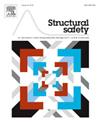Seismic risk assessment methodology for large-span CFST arch bridges in near-fault areas based on fragility analysis
IF 6.3
1区 工程技术
Q1 ENGINEERING, CIVIL
引用次数: 0
Abstract
Large-span concrete-filled steel tube (CFST) arch bridges are widely built in high-seismicity mountainous areas in China due to their low maintenance costs and high adaptability to the challenging construction environments. The dynamic response of such bridges under seismic loading is highly complex, and their seismic performance is a major concern for multiple stakeholders. This study proposes a seismic risk assessment method for large-span CFST arch bridges from a risk perspective, based on seismic fragility analysis. The method begins with seismic hazard analysis of the bridge site, followed by seismic risk scenario identification of the bridge through fragility analysis, then quantifies the seismic risk scenarios from the perspective of economic losses, and finally evaluates the quantified results of discrete risk scenarios based on tolerance theory. A CFST arch bridge located in a near-fault area is analyzed as a case study, with two design schemes and five annual earthquake frequencies considered to validate the feasibility of the proposed method. The research results show that the seismic risk assessment method effectively identifies risk scenarios and their characteristics across different design schemes and seismic frequencies. Additionally, as the method presents results through macro risk tolerance zone divisions, it offers more intuitive and stakeholder-friendly outputs compared to traditional engineering-technology-based assessments (e.g., seismic fragility curves). Overall, the proposed method serves as a robust decision-making tool for the design, operation, and maintenance of large-span CFST arch bridges and similar structures with complex seismic responses.
基于易损性分析的近断裂带大跨度钢管混凝土拱桥地震风险评价方法
大跨度钢管混凝土拱桥由于其维护成本低、对恶劣施工环境适应性强等优点,在中国的高震山区得到了广泛的应用。此类桥梁在地震荷载作用下的动力响应非常复杂,其抗震性能是各方关注的焦点。基于地震易损性分析,提出了一种基于风险视角的大跨度钢管混凝土拱桥地震风险评估方法。该方法首先对桥梁场地进行地震危险性分析,然后通过易损性分析对桥梁进行地震风险情景识别,然后从经济损失角度对地震风险情景进行量化,最后基于容差理论对离散风险情景量化结果进行评价。以近断裂带的钢管混凝土拱桥为例,考虑了两种设计方案和5个年地震频率,验证了所提方法的可行性。研究结果表明,该方法能有效识别不同设计方案和不同地震频率下的地震风险情景及其特征。此外,由于该方法通过宏观风险容忍区划分来呈现结果,与传统的基于工程技术的评估(例如地震易损性曲线)相比,它提供了更直观、更有利于利益相关者的输出。总体而言,该方法可为大跨度钢管混凝土拱桥及类似复杂地震响应结构的设计、运行和维护提供可靠的决策工具。
本文章由计算机程序翻译,如有差异,请以英文原文为准。
求助全文
约1分钟内获得全文
求助全文
来源期刊

Structural Safety
工程技术-工程:土木
CiteScore
11.30
自引率
8.60%
发文量
67
审稿时长
53 days
期刊介绍:
Structural Safety is an international journal devoted to integrated risk assessment for a wide range of constructed facilities such as buildings, bridges, earth structures, offshore facilities, dams, lifelines and nuclear structural systems. Its purpose is to foster communication about risk and reliability among technical disciplines involved in design and construction, and to enhance the use of risk management in the constructed environment
 求助内容:
求助内容: 应助结果提醒方式:
应助结果提醒方式:


